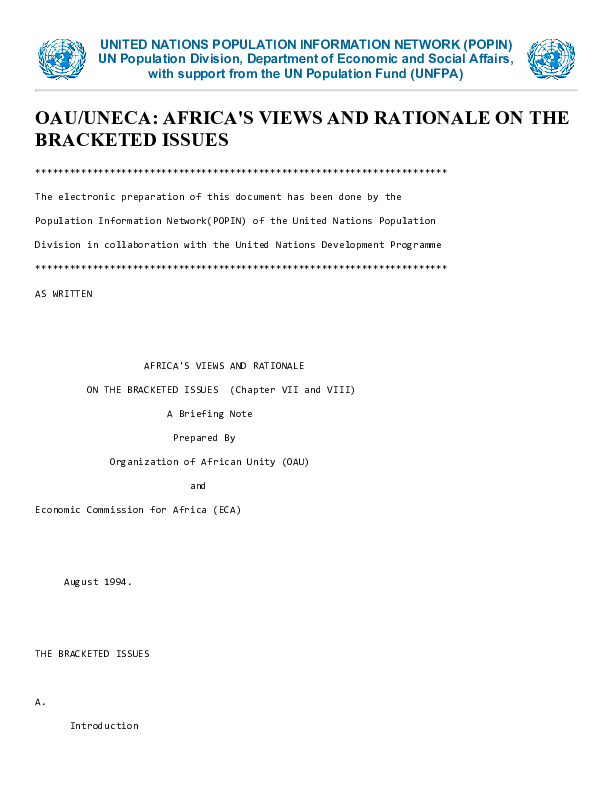
ICPD Library Resource
Africa's Views and Rationale on the Bracketed Issues (Chapter VII and VIII)
Resource date: Aug 1994

ICPD Library Resource
Resource date: Aug 1994
A Briefing Note Prepared By
Organization of African Unity (OAU)
and
Economic Commission for Africa (ECA)
August 1994.
THE BRACKETED ISSUES
A. Introduction
1. Some of the phrases and concepts used in chapters V, VII and VIII of the draft programme of action of the ICPD caused a hot debate and also disagreement among delegates of the Holy See, Latin American and few African countries during the Third Session of the Preparatory Committee for the ICPD held at New York, USA, 4-22 April 1994.
2. These phrases and concepts which were controversial were put in brackets until consensus will be reached in the Pre-Conference meeting of the ICPD scheduled to take place 3-4 September 1994 at Cairo.
B. The Meanings of Some of the Phrases and Concepts Put in Brackets
3. Fertility Regulation: This concept refers to the idea of being able to decide on the number of children, timing and spacing of births or postponing pregnancy through the use of safe contraceptives. it also implies the availability of the information and the service needed for fertility regulation.
4 Sexual and Reproductive Rights: This mainly refers to the basic rights of individuals and couples to have children and to be able to decide the number, spacing and timing of their children. Sexual and reproductive rights also imply that reproduction is a decision of individuals made on their own free will and love to each other without coercion or violence. The violation of sexual and reproductive rights and the lack of information and service to regulate fertility usually force women to resort to abortion.
5. Sexual and Reproductive Health: This refers to information and education activities pertaining human sexuality and human reproduction. This is an important service both to adolescents and even adult people because this enable people to know and understand the growth and development of the human body in general and the sex organs in particular. Knowledge on how pregnancy occurs, the sexually transmitted diseases and their prevention; family planning and the responsibilities of men and women on their sexual behaviour and in reproduction are all dealt in sexual and reproductive health education.
6. Pregnancy Termination: This is a medical concept which implies safe abortion performed by a qualified medical personnel in case of a rape, incest or during a complicated pregnancy which threatens the life of the mother.
7. Family Planning and Reproductive Health: This is a strong maternal and child health services including family planning. Family planning is a programme which enables families to freely decide on the number, timing and spacing of their advocated or recommended as a right or as a method to be used. What is being suggested or recommended instead is safe motherhood, family planning, reproductive rights and reproductive health which are essential health services and key to avoid the risks of undergoing the termination of pregnancy.
D. The Health Situation of Mothers and Children in Africa
15. The health status of mothers and children in Africa is perhaps one of the lowest among the regions of the world. Out of the half million women dying every year world wide, from causes related to pregnancy and child birth, 150,000 of them are Africans. The maternal mortality ratio in Africa is 640 per 100,000 live births compared to only 30 in the developed countries. This extremely high maternal mortality ratio is very much compounded by the high fertility rate of women in Africa which is above 6 children per woman.
Table 1 Estimates of Maternal Deaths and Maternal Mortality Ratio by Regions.
------------------------------------------------------------------------
| Ser.No Region Number of maternal Maternal mortality
deaths (in thousands) per 100,000 live birth
-----------------------------------------------------------------------------------------------
1. Africa 150 640
2. Asia 308 420
3. Latin America 36 270
4. Developed Countries 6 30
5. World 500 390
----------------------------------------------------------------------------------------------
Source: ECA/POP/TP/88/2 (1.3) Addis Ababa, September 1989.
16. The average infant mortality rate in Africa of 114 deaths per 1000 live births is two times higher than the average in Western Europe and North America and twice as high as that prevailing in Latin America.
Table 3 Adolescent pregnancy rate among girls aged 15-19 years.
------------------------------------------------------------------------
Region Percent
------------------------------------------------------------------------
Africa 18
Latin America 8
North America 5
Europe 3
Asia 3
Oceanic 3
Source: UNICEF and OAU, Africa's Children, Africa's Future, Dakar, Senegal, 1992.
20. Unplanned and unwanted pregnancies among women also become causes of many deaths. Such women in the absence of other choices go for illicit abortion and easily loose their lives or if they survive death they suffer a life long disabilities and handicap of their bodies.
21. This is the actual situation and realities we are faced within Africa. Very high maternal, infant and child mortality. The root causes of these high infant, child and maternal mortalities are: Poverty, ignorance and lack of essential health services. Others include urbanization, changing life style, weakening family ties, breakdown of traditional values that ban premarital sexual activity inadequate sex information and education and above all low rates of use of contraceptive methods and lack of access to them.
E. Conclusion
22. The health problems of African women and children cannot be solved unless actions are taken to drastically improve the roles and status of women.
23. The organization and delivery of essential health care (reproductive health care) which promotes safe motherhood and child survival through a strong maternal and child health care including family planning are the means to avoid not only early death and suffering of women and children but also the risk of terminating pregnancy.